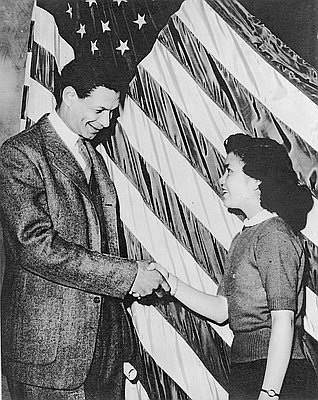- Catalog No. —
- OrHi 94806
- Date —
- 1910
- Era —
- 1881-1920 (Industrialization and Progressive Reform)
- Themes —
- Arts
- Credits —
- Oregon Historical Society
- Regions —
- Portland Metropolitan
- Author —
- Rose Festival Collection, Lot 431
Portland Rose Festival, 1910
This charming horse-drawn float participated in a parade in Portland’s Third Annual Rose Carnival. The event would eventually be known as the Rose Festival Parade. The first carnival, in 1907, was quite different from the month of events which are now an official part of Portland’s Rose Festival. In its first year, the rose enjoyed the spotlight, and from 1908 to 1914, a king ruled Rosaria. It was not until 1930 that queens and princesses from public high schools began being selected for representation at the Festival.
The idea of a rose to represent the city’s festival developed at the close of the 1905 Lewis and Clark Exposition when Portland Mayor Harry Lane proposed a “Festival of Roses” that would help to preserve the national reputation and name recognition that Portland had earned by hosting the Exposition. The germ of Lane’s idea probably originated with rose competitions hosted by Portland’s avid gardeners. In fact, an even older tradition of roses predates western contact: Fossil evidence suggests that various wild roses predate humans on the west coast, and prized hybrids arrived with the earliest settlers.
In 1888, Mrs. Henry Pittock invited rose enthusiasts from among Portland’s high society to show — or more rightly perhaps, their gardeners’ — finest roses at a tent erected at her home on what is now the Pittock Block in downtown Portland. The following year, the Portland Rose Society was founded by attorney Frederick V. Holman. The two-day fiesta that the society held every year grew so large that, in its heyday, flowers overflowed seven blocks of downtown Morrison Street.
Further Reading:
Donahue, Mike. Portland Rose Festival: For You a Rose in Portland Grows. Helena, Mont., 1996.
Written by Trudy Flores, Sarah Griffith, © Oregon Historical Society, 2002.

